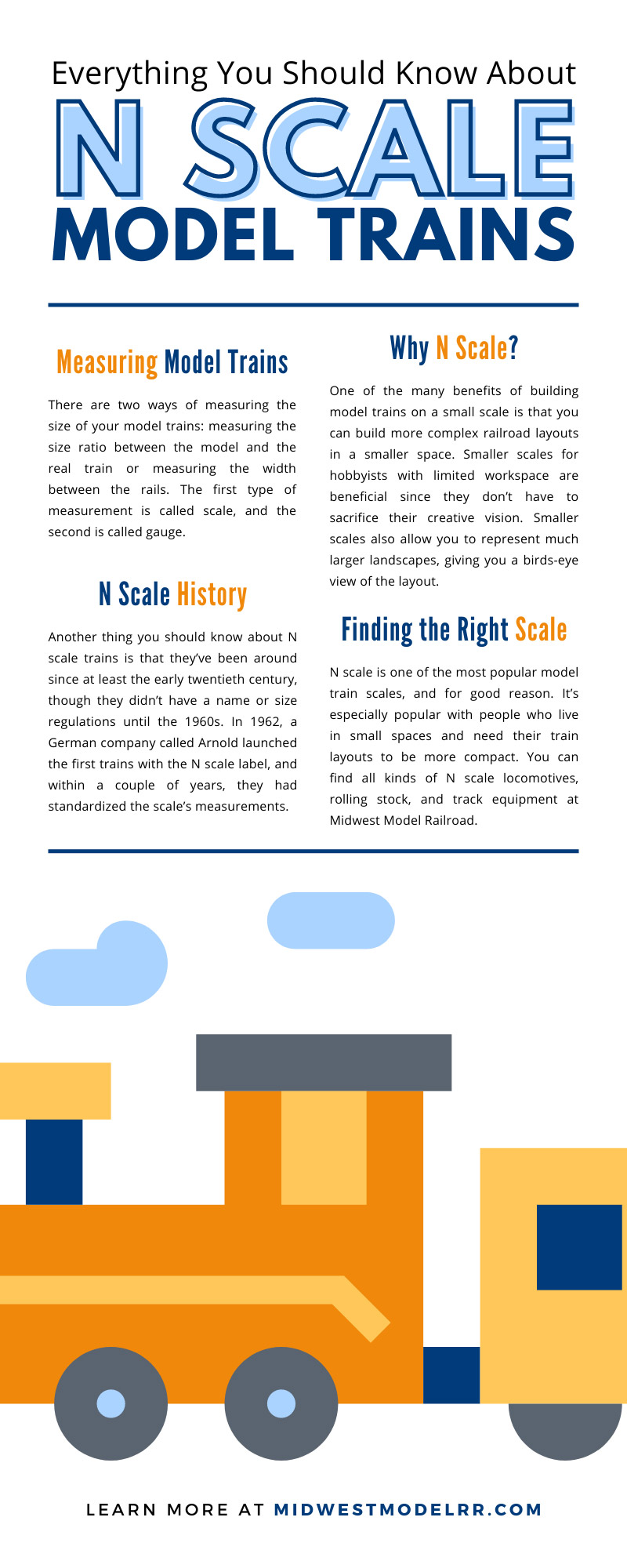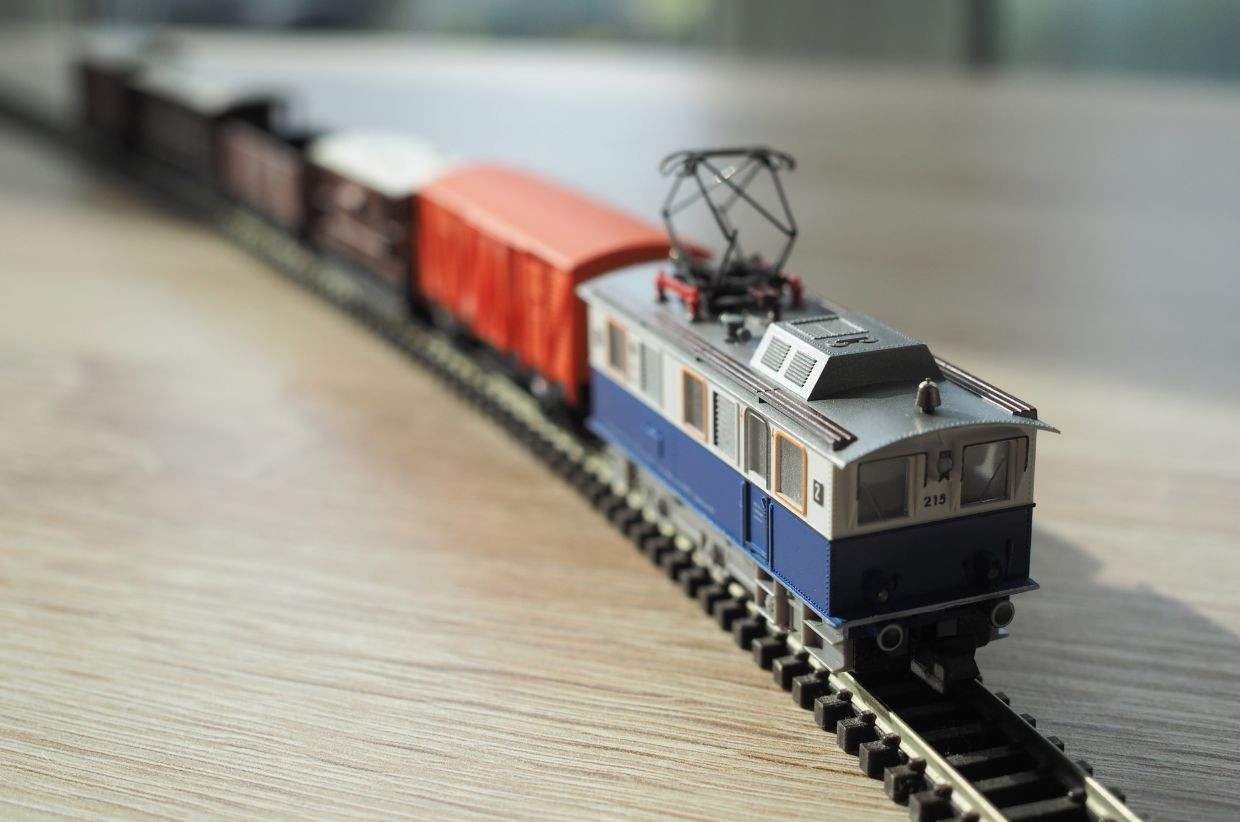Everything You Should Know About N Scale Model Trains
If you’re new to model trains, you’ve probably heard the terms “gauge” and “scale” without knowing precisely what they mean. Essentially, both terms refer to the different sizes of trains and tracks, though they measure different parts. Here’s everything you should know about N scale model trains, which are one of the world’s most popular scales.
Measuring Model Trains
There are two ways of measuring the size of your model trains: measuring the size ratio between the model and the real train or measuring the width between the rails. The first type of measurement is called scale, and the second is called gauge.
Train Scales
N scale model trains are just one of many different scales used in the model train world. In most of the world, N scale has a size ratio of 1:160, meaning it would take 160 model train cars lined up end-to-end to reach the length of the real deal.
However, other countries have slightly different ratios to reflect the real trains in those countries. Compared to other scales, N scale is one of the smallest scales, with only Z scale and T scale being smaller.
Track Gauges
Gauge is an expression of the width between rail heads on a piece of train track. In the real world, there are different track gauges, so it should be no surprise that model trains also have different track gauges.
A standard gauge track mimics the width of an actual North American standard gauge track, which is four feet and eight-and-a-half inches wide. Narrow tracks are typically only about three feet wide.
When buying a model train, you can find N scale model trains that use either standard gauge or narrow gauge track. If you ask a hobby shop for a track without specifying the gauge, you’ll probably get a standard gauge since it’s more common. However, you should be aware that N scale trains from other countries may have different gauges that reflect the real-world standards around the globe.
Why N Scale?
One of the many benefits of building model trains on a small scale is that you can build more complex railroad layouts in a smaller space. Smaller scales for hobbyists with limited workspace are beneficial since they don’t have to sacrifice their creative vision. Smaller scales also allow you to represent much larger landscapes, giving you a birds-eye view of the layout.
N Scale History
Another thing you should know about N scale trains is that they’ve been around since at least the early twentieth century, though they didn’t have a name or size regulations until the 1960s. In 1962, a German company called Arnold launched the first trains with the N scale label, and within a couple of years, they had standardized the scale’s measurements.
One of the things that helped N scale become so popular was the type of coupler that Arnold designed for their line of N scale model trains. A coupler is the name of the connection between two train cars. Arnold called their version the “Rapido” coupler, and it allowed for much faster changes to a train car lineup.
What made the Rapido coupler so important was its standardization for N scale trains. This meant that hobbyists could buy trains from different manufacturers and still be able to attach them to one another. This allowed people to have greater creative control over their model trains.
Building in N Scale
If you’re new to using N scale, there are some considerations you should keep in mind as you plan and build your track.
Layout Size
The traditional size for a model train layout is four by eight feet, which gives you enough room for at least a few exciting curves and inclines. Honestly, your creativity is the only limit regarding layout complexity, though working at smaller scales helps to give you more room to work in.
Layout Height
Since N scale trains are so small, some model train hobbyists recommend raising the height of your layout if you’re building your own base. It can be nice not having to lean down to inspect your track, and it’s probably better for your neck and shoulders.
Scale Scenery
When choosing scenery to decorate your layout, keeping your train’s scale in mind is important. Since scenery isn’t always sold to a specific scale, you may have to do some math to figure out how tall things should be. Here’s a quick guide to get you started:
- Mature oak tree: 5.25 in
- Adult person: 10-12 mm
- Doors: 10-12 mm. (same for a person)
When it comes to scenery, it’s not always about realism, however. Since you want the focus to be on your trains, making things like trees a little smaller than they would be in real life is okay. You don’t want them blocking the view!
Most model train hobbyists worry only about creating the illusion of depth and space for mountains and backdrops. Scale mountains would likely take up your entire layout, so making them smaller is okay.
N Scale Variations
If you’re from the United Kingdom or Japan, you may find that N scale and N gauge are slightly different sizes than other model trains. Here’s what you need to know about the differences.
N Scale: United Kingdom
In the UK, N scale trains are a bit smaller than in other parts of the world. The standard N scale is 1:148 instead of 1:160, though these trains can still run on the same N gauge track. While this tiny difference matters to some purists, it’s not an issue for most people.
N Scale: Japan
Japan’s real-world trains run on several track gauges and may also differ in scale from North American trains. Scales of 1:150 and 1:120 are popular in addition to 1:160. These trains may use narrower track gauges based on real-world tracks that measure three-and-a-half feet.
Finding the Right Scale
N scale is one of the most popular model train scales, and for good reason. It’s especially popular with people who live in small spaces and need their train layouts to be more compact.
You can find all kinds of N scale locomotives, rolling stock, and track equipment at Midwest Model Railroad. Call or email us if you have any questions about which scale is right for you!

Recent Posts
-
Prototype Spotlight: GE ES44AC — Modeling a Modern Freight Workhorse
Prototype Spotlight: GE ES44AC — Modeling a Modern Freight Workhorse Published 2025-09-29• 8–10 min
-
How to Build a Realistic Freight Yard: Flow, Trackwork, and Car Management
How to Build a Realistic Freight Yard: Flow, Trackwork, and Car Management Published 2025-09-25 • 8
-
Scenery Basics: From Foam to Foliage — A Quick, Budget-Friendly Guide | Midwest Model Railroad
Modeling Tutorial Scenery Basics: From Foam to Foliage Published 2025-09-23 · 7–9 minute read Li




